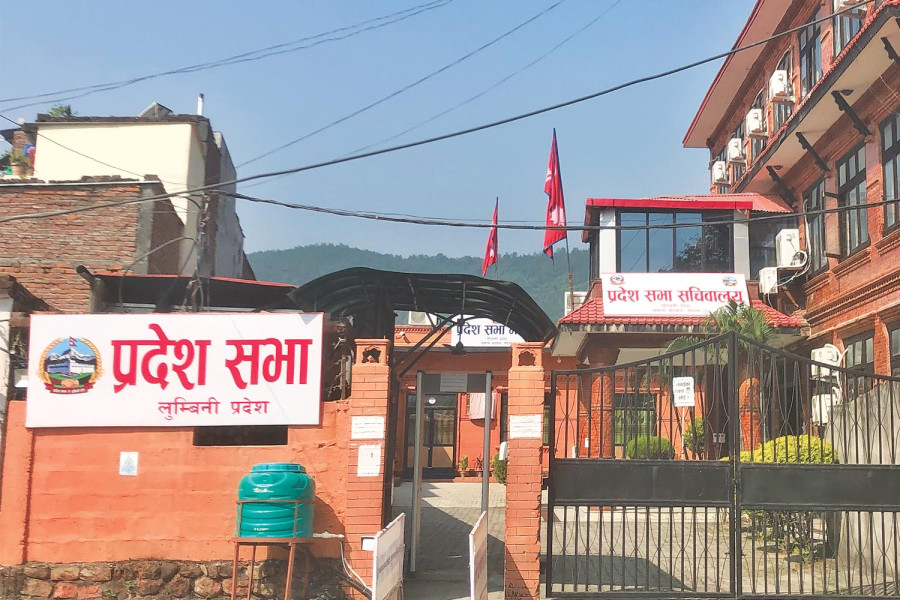Columns
Are the provinces truly a burden?
The institutionalisation of the provinces has been neglected by the federal government and key party leaders alike.
Khim Lal Devkota
Federalism, republicanism, secularism, inclusiveness and the rule of law are key pillars of Nepal's constitution. Disrupting even one of these pillars jeopardises the constitution and risks plunging the country into conflict. The provincial level symbolises federalism, but it faces significant criticism. The provincial structure was introduced to address the Madhesh Movement and the Maoist insurgency. However, this change has not been widely accepted, leading to calls for eliminating the provincial structure altogether.
The institutionalisation of provinces has been hampered and neglected not only by the federal government but also by leaders from key political parties. The constitution grants exclusive and shared rights to the provinces, requiring the authorities to make laws, form annual budgets and decisions, and formulate and implement policies and plans. The provinces, however, began with no prior experience, leading to a prolonged period of trial and error. This has resulted in unfair criticism and calls for the abolition of provinces.
Systemic delays
The federal government's delay in enacting the Federal Civil Service Law has led to a chaotic personnel administration system in the provinces. While provinces have issued the civil service acts, the federal recognition of promotions remains inconsistent. Federal employees assigned to provinces often rest unmotivated and disconnected from local needs. This undermines provincial governance as these employees are less responsive to provincial authorities. A similar issue exists in the education sector. The School Education Bill in Parliament lacks clear national standards for school education and has bypassed the exclusive right of the local level.
The federal government is introducing new bills related to universities, but my concern lies in constitutional grants that give provinces the right to establish provincial universities. While provinces are establishing universities, the federal government is simultaneously introducing its own university bills. When I was a member of Parliament, I argued that the higher education bill and education policy should be prioritised, and only then can universities be established. However, I received no support from my colleagues.
Many assert that the provincial structure has become expensive and burdensome. However, provincial expenditures constitute only 10 percent of the total expenditures across federal, provincial and local levels. How can a structure spending merely 10 out of 100 rupees be deemed burdensome?
Federal government ministries have withheld and spent budgets meant for the provinces indiscriminately. For instance, the Ministry of Physical Infrastructure has a budget of Rs150 billion, while the Ministry of Urban Development has around 100 billion. Some ministries have budgets as high as Rs250 billion. In contrast, the combined budget of all seven provinces for FY 2024-25 is only Rs279 billion. Meanwhile, the ministers of the Physical Infrastructure and Urban Development Ministries together control budgets larger than those of all seven provinces combined. This discrepancy highlights the centralised control over resources that should be allocated to provinces.
The matter of size
The constitution considers provinces to be the key pillars of development. However, many federal ministries have retained small-scale programmes and projects that should fall under provincial jurisdiction. Despite this, if the provincial structure is considered cumbersome, we can reduce the number of provincial ministers. Similarly, reducing the number of provincial members is also necessary. However, streamlining federal governance and aligning it with the constitutional spirit requires significantly reducing the number of federal ministers. If we follow the constitutional mandate properly, the budget of federal ministries would go to the sub-federal level.
The constitution provides state power to provinces (Article 56) but lacks its own staff, police force, adequate financial resources and land acquisition. During budget preparation and execution, provinces often face a shortage of finance secretaries and staff. The annual report of the Office of the Auditor General (OAG) indicates a shortage of 11,000 employees in the provinces. Reports from constitutional commissions, including the OAG, reveal federal government’s non-cooperation with sub-federal levels and interference in policy formulation, budget implementation and personnel management.
Provinces have been hindered by political mismanagement, federal centralisation and inadequate intergovernmental relations. To realise the potential of federalism, it is crucial to decentralise authority, improve cooperation, and support provinces in their development journey. Only through these reforms can Nepal's provinces become effective and autonomous entities within the federal system. By addressing the challenges of origin, acceptance, duplication of efforts and fiscal mismanagement, provinces can enhance their effectiveness and contribute to the overall federal system.
Reforming the system
Several reforms are necessary to empower and strengthen provinces. The federal government must respect constitutional provisions and allow the provinces to manage their police, staff, and other key areas independently. There is a need to organise regular meetings and functional mechanisms for cooperation, coexistence and coordination among federal, provincial and local governments. National standards across all government levels should be developed and enforced to ensure uniformity in services and goods provided.
Political leaders' attitudes towards provinces remain unenthusiastic. Chief ministers cannot act independently and need party leaders' consent even for minor decisions. For provinces to function effectively, political parties must align their structures with the provincial system. Provincial committees should be empowered, and accountability systems should be established, linking the federal government to the central committee, the provincial governments to the province committees, and the local government to the district committee. However, considering the international practice of province management and the centralised thinking of Nepal's political parties, these improvements seem unlikely.
During Prime Minister Pushpa Kamal Dahal's tenure, provinces could still not utilise police powers. Chief ministers' voices are often unheard due to provincial instability. They have also been neglected and bypassed in the fiscal transfer system. For instance, in FY 2018-19, provinces received Rs123 billion in grants from the Government of Nepal. Although the budget increased by Rs500 billion over six years, the grant amount to provinces in FY 2024-25 decreased to Rs96 billion—27 billion less than six years ago.
Reforms for stability
Provinces can effectively lobby the federal government only when they are stable. This requires constitutional amendments through electoral system reforms. Provinces include a mixed electoral system like the federal Parliament, and the proportional electoral system should be abolished in favour of the first-past-the-post system with ensured proportional and inclusive representation. This would require ensuring seats for women, Dalits, tribals, Muslims, and backward classes within the direct election system. This method will decrease the number of provincial assembly members and likely result in one or two parties gaining a majority.
Alternatively, a directly elected chief ministerial system, with accountability to the provincial Assembly and requiring a two-thirds majority for removal, can also provide stability.
Additionally, reforming the number of provincial ministers is necessary. Limiting ministers to 10 percent of provincial assembly members, with a minimum of five, is a viable option. Most countries, whether at federal or provincial levels, have limited numbers of ministers. For instance, the Swiss constitution mandates just seven federal ministers, including the president. Reducing the number of federal ministries and aligning provincial governance structures with constitutional provisions are crucial steps in strengthening Nepal's federal system and ensuring effective provincial governance.




 5.12°C Kathmandu
5.12°C Kathmandu















